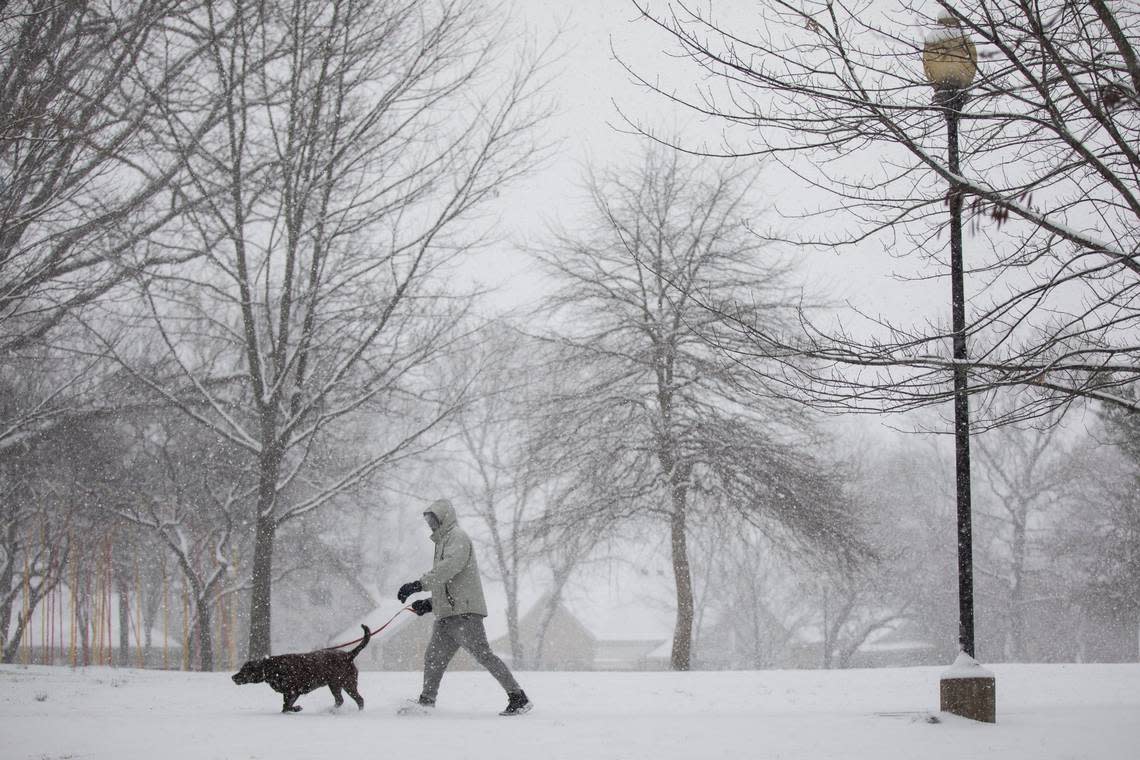Need to go out in Kentucky’s arctic cold? Check out these tips to help you dress warmly

Sub-zero wind chills are in the forecast for Central Kentucky Wednesday morning, and minor accumulations of snow will continue to be possible as late in the week as Friday.
What’s more, another dome of icy air is expected to move into the region this weekend, according to Tuesday’s hazardous weather outlook from the National Weather Service in Louisville.
For the Lexington area, the agency’s forecast calls for wind chill values as low as minus 5 degrees Fahrenheit Tuesday, with wind chills dropping to minus 9 Tuesday night. Expect similar conditions Wednesday morning, with minus 9 wind chills and 25-mile-per-hour wind gusts.
In a special weather statement, the NWS said the mix of single-digit temperatures and light to steady winds is plunging wind chills below zero.
“Minimum wind chills near 10 below may occur in some locations, and prolonged exposure at those temperatures could lead to frostbite. Please use caution if you plan to be outside either morning through mid-week,” the agency said.
Under these conditions, icy roads and frigid temperatures can be a danger for drivers on the road, but there are also risks for those who are stuck outside, including emergency workers and the unhoused. Among the risks are frostbite and frostnip. Any exposed body parts, such as the ears, nose, lips or hands, are at risk.
Hypothermia is also a concern for some, and it occurs when the body loses heat too quickly, dropping to a dangerously low temperature that can cause organ failure or even death if left untreated, according to the Mayo Clinic.
While you should avoid going out if you can, some don’t have that luxury. If you do have to go out, here are a few important rules to keep in mind about what to wear and what to know about hypothermia and frostbite.
How should I dress for extreme cold?
If you do have to go outdoors in extremely cold weather, perhaps to walk the dog, you should be mindful of what you wear. It’s easy to think you don’t need a hat or gloves to cover up your ears or fingers when you’re only going outside for a few minutes.
Still, you might be surprised how quickly frostbite can occur. Cold winds, or wind chill, rapidly sap heat from your body, and a good breeze can dramatically shorten the time it takes for frostbite to set in on any exposed skin.
Frostbite can occur in 15 minutes or less at wind chills of 18 degrees below zero, according to the Texas Department of Insurance. At a temperature low of 5 degrees Fahrenheit, it only takes a wind speed of about 25 or 30 miles per hour to produce a wind chill that cold. That kind of wind speed amounts to a strong breeze at best, according to the NWS.
The Mount Sinai hospital system advises dressing in layers and wearing the right shoes in extreme cold. It’s not just about keeping the cold out, but holding onto as much heat as you can.
According to Mount Sinai, you should think about the following if you’re spending time outdoors in extremely cold weather:
Wear an inner layer of clothing designed to wick sweat away from your body. Think lightweight wool, polyester or similar fabrics. Skip cotton in cold weather, including your underwear. Cotton offers poor insulation and absorbs moisture, trapping it near your skin, which in turn just makes you colder.
You need a middle layer to insulate you and keep the heat in. A polyester fleece, wool or down are great options. You may even need several middle layers depending on what you’re doing outdoors.
Last, pick an outer layer of clothing that will repel wind, snow and rain. Look for a fabric that is breathable and rain and wind resistant. It’s important the outer layer is breathable because sweat will build up and make you cold.
Now that you’ve protected your core, don’t forget to protect your ears, face, neck, feet and hands. Consider wearing the following:
A warm hat, like a toboggan
Something to cover your face, like a ski mask
A scarf
Mittens or gloves, though mittens will be warmer
Wool socks
Some warm, waterproof shoes or snow boots. No sneakers or tennis shoes
Managing your layers in cold weather is another skill you need to master. Learn to take off your layers when you begin to get too hot and sweaty, and add them back when you cool down again.
Watch for the warning signs of frostbite and hypothermia
Be on the lookout for these early signs of hypothermia or frostbite, as explained by Mount Sinai.
Early frostbite, called frostnip, looks like the following:
Red and cold skin. The skin could start to turn white, but is still soft
A tingling, prickling or numb sensation
Stinging
Early symptoms of hypothermia include:
Feeling very cold
Shivering (which may stop as hypothermia progresses)
The “umbles.” Stumbling, bumbling, grumbling or mumbling. These indicate the cold is getting to you and affecting your brain and body, inhibiting it
If you notice these warning signs, either in yourself or someone else, call 911 immediately.
Do you have a question about Kentucky weather for our service journalism team? Let us know via the Know Your Kentucky form below or email us at ask@herald-leader.com.

